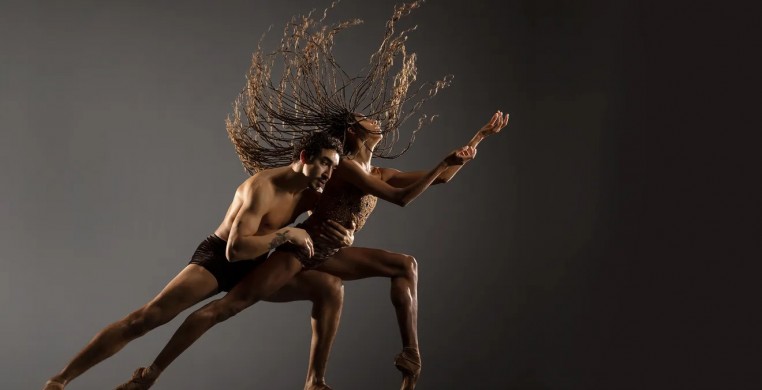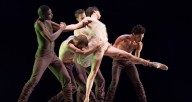Alonzo King LINES Ballet’s “Deep River” (2022) dazzled Chicago audiences in an all-too-brief return to Harris Theater (May 5-6). The epic work launched the company’s 40th Anniversary season in its home-town premiere in San Francisco.
Conceived and created during the Pandemic, in collaboration with composer/musician Jason Moran and vocalist Lisa Fischer, “Deep River” soars along a highway to the heavens, taking us on a journey from chaos and despair to revelation and deliverance.
Borrowing from the Biblical Exodus, “Deep River” enthralled and mesmerized the multi-generation Harris audience at the May 5th Family Matinee for an episodic 75-minutes, combining the most sublime levels of artistry to tell its story.
The multi-disciplinary production is the result of King’s collaboration with composer/musician Jason Moran and vocalist Lisa Fischer. Due to health issues, Fischer could not perform live with Alonzo King LINES Ballet for these performances. A recording of her vocals, inspired by traditional Black spirituals, was blended with Moran’s live piano performance from the Harris Theater orchestra pit.
Crossing a metaphoric Jordan River to reach a personalized “promised land,” love is the redemptive force.
In the program notes for “Deep River,” Alonzo King says, that LINES Ballet is dedicated to building community through the performance and teaching of the arts. “We strive to make obvious that art is the inheritance of every individual, that art activates evolutionary growth, is an intellectual virtue, and the fostering principle for all that is made, done, or known.”
The matinee performance of “Deep River” gave us a splendid opportunity to experience that mission first hand.
Before the actual performance began, the company rehearsal director came out in front of the curtain and introduced the program to an audience filled with parents, grandparents, and kids who ranged from tots to teens.
She invited the audience to respond to what they were about to see in any way they wanted, calling out to the dancers, clapping, cheering, or vocalizing if what they saw on stage moved them to respond.
“Deep River,” conceived during the Pandemic, unfolded in segments set to Moran’s score with transitions between segments performed to the sound of silence, which became its own “music.”
The curtain rose and lights came up on a solo woman. Soon she was joined by a chorus of men and women. Liquid arms that had no bones, hands and fingers that doubled as silken fringe, and legs that went on forever defined both male and female bodies. Sharp arm jabs alternated with languid upward beseeching, head focusing to the heavens. Subtle impulses isolated upper body, core, abdomen, pelvis and extremities, transforming ballet technique into a whole new species.
The racially diverse company of a dozen or so men and women began dressed simply in designer Robert Rosenwasser’s earth-toned palette, men, bare-chested and wearing either tights or drapey amber/orange skirts, tights, or pants, and the women in neutral-toned tunics.
Bodies clutched, agitated, then released into flowing spiral turns.
A blur of fluttering hands across space would end in a sudden, striking halt, with constant folding and unfolding, expanding and retracting throughout much of the work. Stage energy went from busy to meditative to lyrical transcendence. Instrumental music and lyrics wafted in and out of focus. In one segment, a man entered carrying a lifeless woman’s body in his arms to the spiritual “Motherless child.” In another, a solo woman pirouetted to “in this world, no one can love me.”
Dynamics and tempos alternated between extremes of speed, agitation and calm, which had the effect of keeping the audience in a state of sensory and emotional alertness throughout the performance.
As the dancers stripped down to the barest of essential costume pieces they became supplicants, offering up themselves, their beautiful dancing bodies, in a blend of movement and prayer. Briefs and tank tops for women and briefs for men, and the addition of pointe shoes for a handful of women rendered their movement at once more vulnerable and more self-actualizing.
Movement shifted to swinging, tossing arms and bodies, to the sound of chimes. The ensemble brought a man and women together, she in a feathered version of a tu-tu. Echoes of “The Rite of Spring.” The ensemble thrusted her at him over and over until she stuck onto him, legs wrapped around his torso. Ae danced for her, she sat and watched him tell her his story, the story that was his body his offering to her. “Ring with the heart;” “Liberty;” “Let our rejoicing raise high as…;” “Freedom!”
A solo male dancer, Babatunji Johnson, brought the stage to a climactic catharsis, his entire being electrifying the stage space. I have never seen anyone dance like this—at once a dancer, a celestial being, a prophet, an escape artist of his own body. His movement reached heights of ecstasy, and then, suddenly, he stopped, turned to face the stage right wings, and walked off stage as if he were crossing the street.
Lyrics wafted in and out across melody: “breakthrough;” “so it shall be;” “you’re holy.” A solo female dancer, Adji Cissoko, extended her leg to her ear, fouettéd to attitude á la second and balanced unsupported en pointe. A collective gasp from the audience registered the magnificence of the moment, at once technically miraculous and emotionally spellbinding.
“Deep River” began a slow march toward its climax with a slapstick male/female duet. They punched and tumbled, tangled and untangled together, fell, twisted, lifted, and folded their bodies into and around each other, their only accompaniment the sound of their own laughter. Finally, they rolled themselves offstage in silence.
In the black-out, a child’s untamed laughter bursted out of the darkness of the Harris Theater audience, and in the crystalline moment of connection across the footlights, the whole audience exploded in laughter.
“Deep River” ended much as it began, except that we had crossed over with them. Crossed the Red Sea. Crossed the Jordan River. Crossed the shackles of enslavement to freedom and hope
Alonzo King’s unique vision and innovative use of ballet as a lexicon for the deepest of human expression rescues the art form of ballet from the confines of its origins in European aristocracy, and offers us, through its cultural diversity of resources, global possibilities for creating human community.


